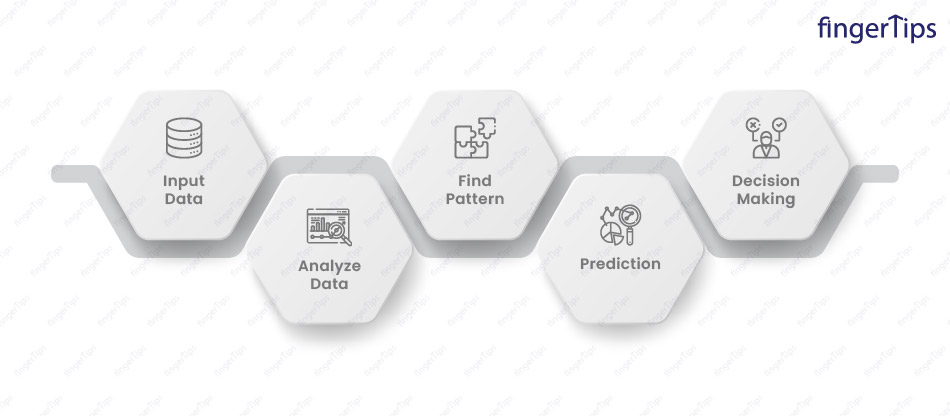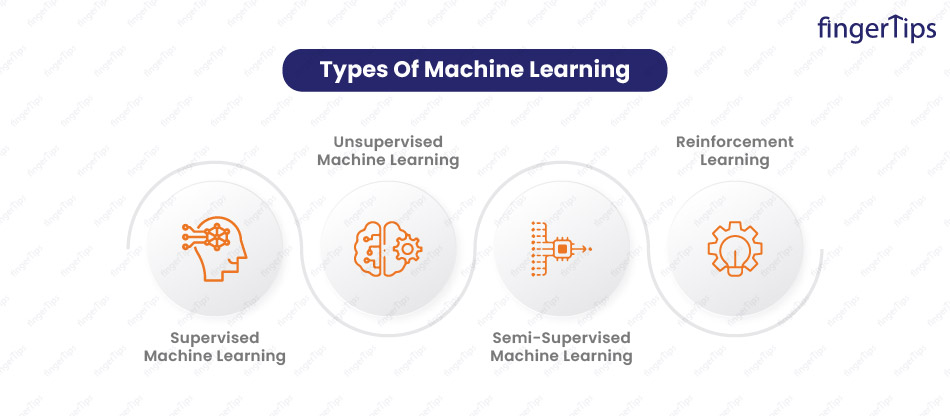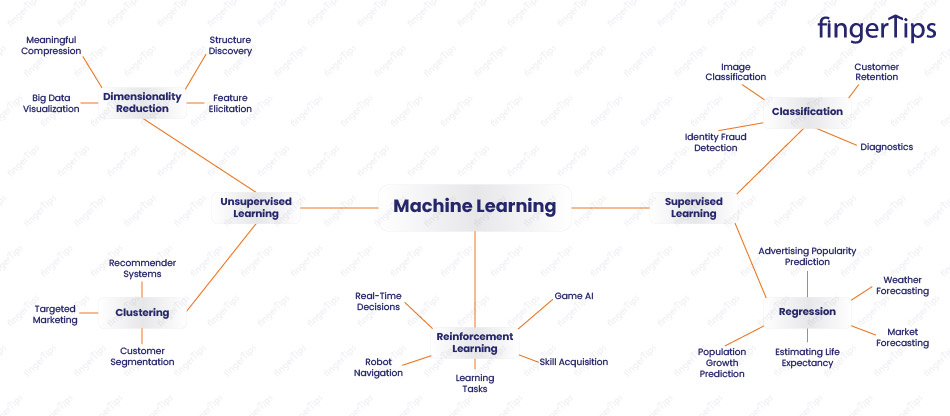Machine Learning is a sub-field of the broader concept of Artificial Intelligence, that focuses on letting machines and computers learn and update them from past data and by identifying the patterns in data. The concept of machine learning is based on continuously providing better outputs. The model tries to learn the data input and make changes and provide better and more accurate output.
The result of the machine learning model is based on two different scenarios:
Input Data: The quality of the input data that is being used is of utmost importance. The higher the accuracy and quality of input data, the higher will be the output quality.
The Model Selected: The concept of machine learning has a variety of different models and algorithms that a data scientist can select from. It is important to select the right method in the right case to acquire the best results. With the growing use of the concept in the technological world, one must wonder what exactly is the use of machine learning. Next, let's first see why do we need machine learning in this introduction to machine learning guide.
Why Do We Need Machine Learning?
Due to the increase in the amount of data, machine learning is constantly proving to be of big help to data scientists and businesses by automating various tasks. With different applications of the machine (explained in the later part of the guide), the concept helps businesses to save their precious resources, i.e., time and money.
Taking one such example of machine learning, it made the concept of a chatbot possible. Due to chatbots, there's no need for a live person to be online 24*7. Instead, a robot will handle customer queries.
Let's see how all this is possible for machine learning:

How Does Machine Learning Work?
There are four different steps in the process of making a successful machine learning model.
Step1: Select The Training Data/Input Data
The first thing needed is good-quality training data for the machine learning process. The training data can be either labeled(classified and filtered) or unlabeled (unclassified and unfiltered). Often the labeled data is used for input, and unlabeled data is used to test the accuracy of a model.
Step2: Finalize An Algorithm
At this step, data scientists are required to select the algorithm according to the problem and the input data. The selection of the algorithm is also dependent on the quantity and quality of the training data.
Step3: Training The Algorithm
The step involves selecting the optimizing methods according to the model requirement. And this method doesn't need any human interference. The machine learning model is capable of learning from the inputted data on its without any or with minimum human guidance.
Step4: Utilizing And Updating The Model
The final step involves providing the model with updated data to get better and optimized output. With this, you must now be clear on how the concept of machine learning works. But do you know what are the key roles or key features of machine learning? Let's see them in our next topic of this guide.
Don't miss out on this opportunity to enhance your skills and take your career to the next level become a Certified Data Scientist-Enroll Now
Features Of Machine Learning
The concept of machine learning comes up with a variety of different powerful features which businesses can certainly not neglect. Let's see some of those features of machine learning:
Automation
One of the major features of the concept is that the machine learning models help in automating a repetitive and tedious task. This allows businesses to employ their valuable resources for other important projects. For example, sending the same repetitive emails to a long list of customers is now being automated with the help of various tools in the market that uses machine learning.
Data Visualization
The data presented by the organization for the analysis purpose is huge in amount. The analysis can't be done on this textual data, and thus, it is important to convert it into visualized form. Machine learning comes up with different tools that easily help in data visualization of both structured and unstructured data.
Customer Service
The priority of any business would be to satisfy the consumer and provide the best possible service to them. Machine learning helps the business to provide personalized service to the consumer.
Adaptability
The important feature of machine learning is the adaptability of the model. The model can be fed with the updated data, and thus, it can provide optimized outputs. As with the recent data, the model then comes up with efficient solutions.
With this, let's explore our next topic, which is types of machine learning.
Types Of Machine Learning
The four broad types of machine learning are explained below: 
Supervised Machine Learning
As suggested by its name, supervised machine learning involves the training of a model on a labeled set of data. In labeled data, patterns and trends are already being separated for the model. In this way, the data act as supervision for the model and helps in providing a suitable output.
This method needs supervision from the external side, that is, from a human, to provide the correct output.
Unsupervised Machine Learning
This machine learning method is the opposite of supervised machine learning. Here, the model doesn't need any supervision or support from humans, and the model is even trained on the unlabeled data set.
The model is capable enough to identify the patterns and trends on its own and provide the output. The machine learning model is first required to classify the data, group it, arrange it and then look for hidden patterns.
Semi-Supervised Machine Learning
This machine learning is a combination of supervised and unsupervised machine learning methods. The model in this type requires both labeled as well as unlabeled data sets for training purposes.
While semi-supervised learning acts on data that contain a few labels and are a middle ground between supervised and unsupervised learning, the majority of the data it uses is unlabeled. Labels are expensive, however, for corporate needs, there might not be many labels.
Reinforcement Machine Learning
Reinforcement learning is more of a feedback-based process where the output is increased by the hit-and-trial method, learning from experience, etc. The model works on a reward-based system.
At the time of correct output, the model or the algorithm is rewarded; on the other hand, at the time of wrong output, it is penalized.
Do you know different types of machine learning models use different machine learning algorithms? Let's see some of the common machine-learning algorithms.

Types Of Machine Learning Algorithms
Support Vector Machine (SVN)
Support vector machines are a group of supervised learning techniques for classifying data, doing regression analysis, and identifying outliers. These are all typical problems in machine learning. They can be used to forecasting potential driving routes using a well-fit regression model or to identify abnormal cells based on millions of photos.
Decision Tree
A decision tree is a visual representation of all options for making a choice given specified circumstances. A decision tree is a supervised machine-learning tool that may be used to classify or forecast data based on how queries from the past have been answered. The model is supervised learning in nature, which means that it is trained and tested using data sets.
KNN Algorithm
K Nearest Neighbor is a classification and regression approach that belongs to the Supervised Learning category. It is a flexible approach that may also be used to resample datasets and impute missing values. It uses K Nearest Neighbors (Data points), as the name implies, to forecast the class or continuous value for a new Datapoint.
K-Means Clustering
The K-means clustering method seeks to build clusters of related elements. K denotes how many groupings there are.The clusters are then placed as points, and all observations or data points are connected to the closest cluster, computed, and adjusted. The procedure is then repeated using the new adjustments, and so on until the desired outcome is obtained.Search engines, market segmentation, analytics, and even astronomy use K-means clustering.
Random Forest Algorithm
An incredibly common supervised machine learning technique used for Classification and Regression issues in machine learning is called the Random Forest Algorithm. To increase the dataset's predictive accuracy, a classifier called Random Forest uses many decision trees on different subsets of the input data.
Disadvantages Of Machine Learning
Selecting An Algorithm
In machine learning, choosing an algorithm is still a manual process. Data must be run through all the algorithms and tested. Only then may one choose the algorithm they wish. It is chosen based on how accurate the results are. The procedure consumes a lot of time.
Inconsistency In Data
ML is always analyzing data. For training and testing, enormous amounts of data are required. Data mismatch can occasionally be caused by this method. The cause is that some data are constantly being updated. Thus, we must wait for the fresh data to come in. If not, the results from the old and new data can be different.
Time-Consuming Process
Many ML algorithms may take longer than you anticipate. Even though it's the finest algorithm, it occasionally surprises people. It will take some time for the system to process huge and complex data sets. Sometimes, this might result in a higher CPU power requirement. Even with GPUs present, it can occasionally get chaotic. Moreover, the data can use more space than is permitted. After seeing the disadvantages of machine learning models and algorithms, one might wonder what the future of machine learning is.
Future Of Machine Learning
The application of machine learning extends beyond the world of investments. Instead, it is growing in all industries, including banking and finance, IT, media & entertainment, gaming, and the auto sector. Let's observe the changes that machine learning will bring about because its reach is so broad. ML will be a crucial component of every AI system, regardless of size. As machine learning (ML) gains exposure in corporate applications, there is a good chance that this technology will be made available as a Cloud-based service called machine learning-as-a-service (MLaaS). ML algorithms will be able to "continuously learn" based on freshly available internet information thanks to connected AI systems. Hardware manufacturers will be rushing to increase CPU power to support ML data processing. More precisely, hardware manufacturers will be forced to modify their products to properly utilize ML's capabilities. Machine learning will aid machines in better understanding the context and significance of data.
Applications Of Machine Learning
E-Commerce Sector
Product suggestion is one of the key components of any e-commerce website and entails the advanced application of machine learning algorithms. Websites keep track of user behavior based on prior purchases, browsing patterns, and cart history, and then use machine learning and AI to provide product recommendations.
Fraud Recognition
Fraud detection is one of the most crucial uses of machine learning. To identify online fraud, the machine learning model closely analyses each customer's profile after they complete a transaction.
Virtual Assistant
Virtual personal assistants facilitate text or voice access to relevant details. The personal assistant searches for information when a request is made for it or looks up answers to previous queries that are comparable to the one being made. Speech recognition, speech-to-text conversion, natural language processing, and text-to-speech conversion are some popular ML techniques used in virtual assistants.
Self-Driving Cars
An unsupervised learning algorithm used by self-driving cars mainly relies on machine learning methods. The vehicle can get data from cameras and sensors about its surroundings, comprehend it, and decide what actions to take thanks to this algorithm.
Identifying Email Spams
Email spam detection is one of the most well-known uses of machine learning that everyone is familiar with. Email service providers create apps with spam filters that categorize incoming emails as spam and route them to the spam folder using an ML algorithm. Other than the mentioned applications, machine learning has various other applications in different industries. In this guide to machine learning, we've seen machine learning for beginners, concepts of machine learning, types of machine learning, features of machine learning, applications of machine learning, the future of machine learning, and all this in detail.







